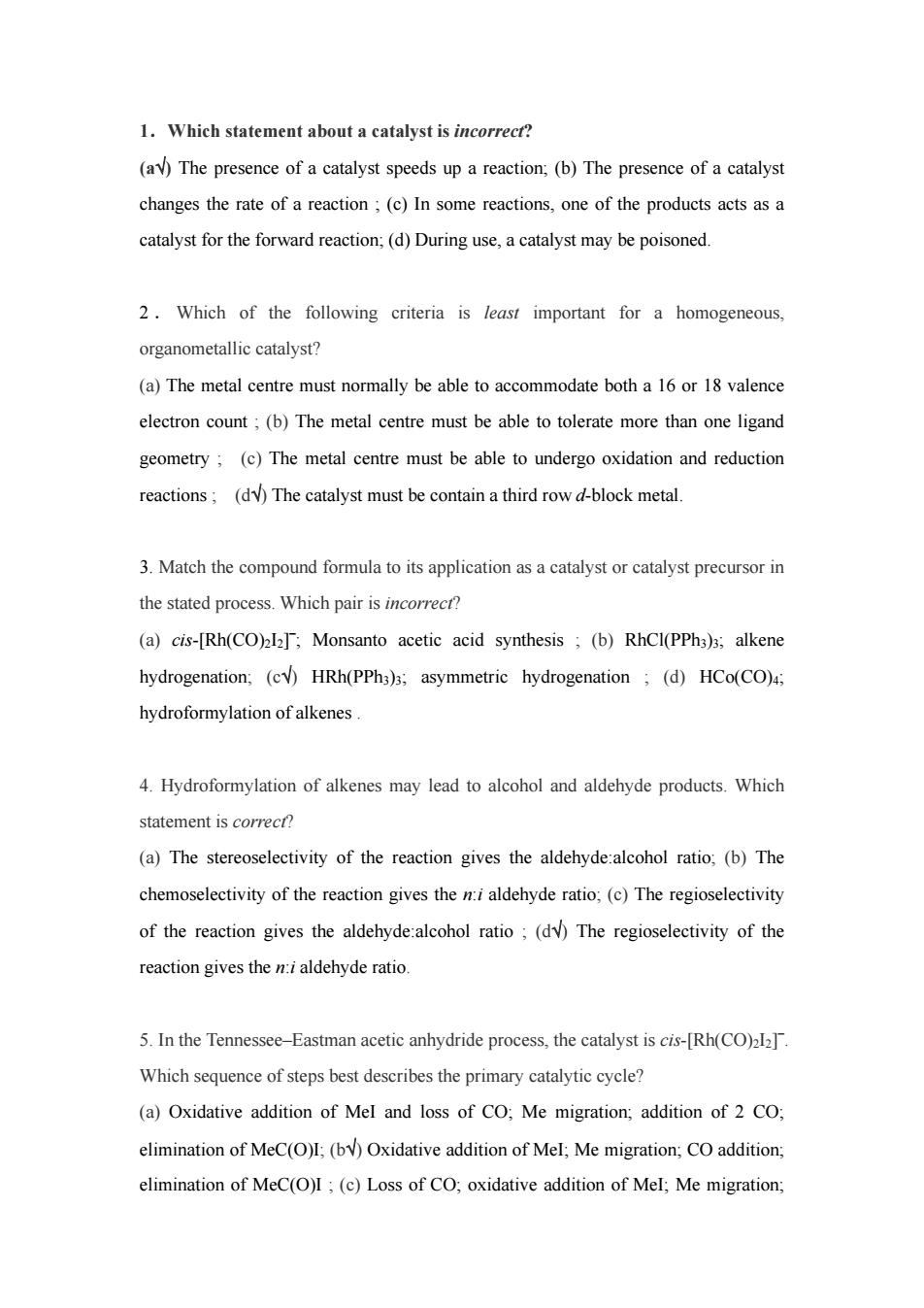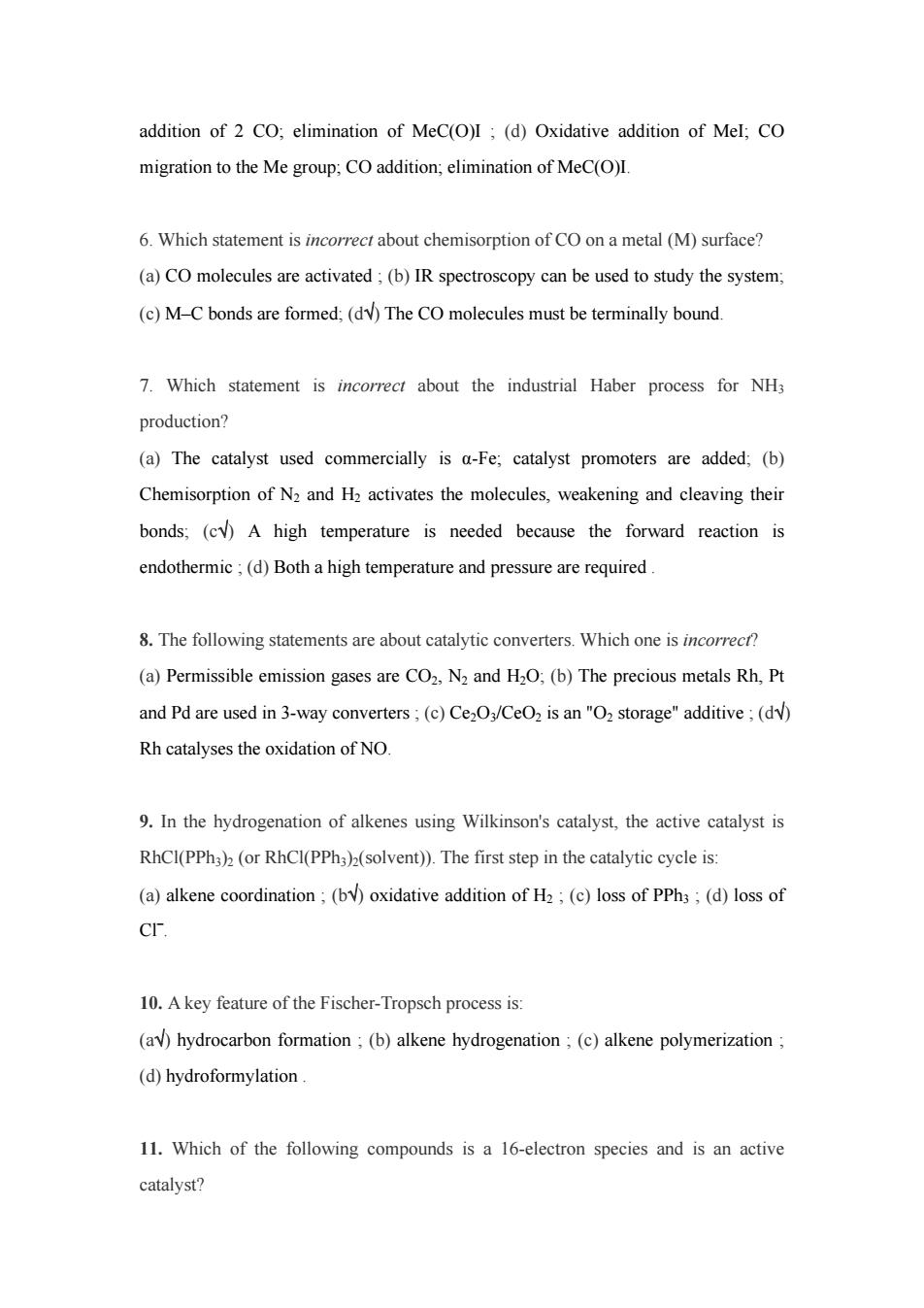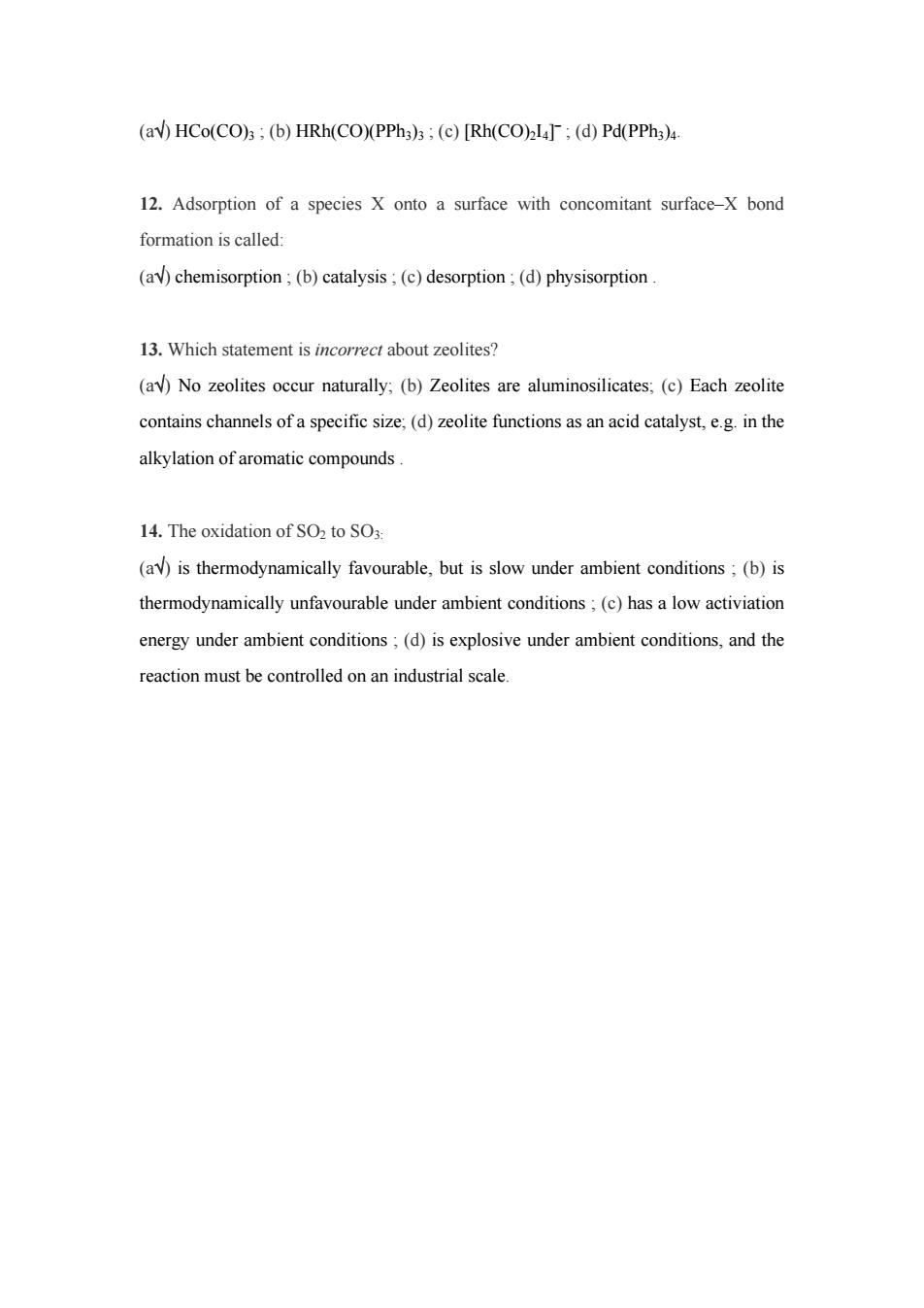
1.Which statement about a catalyst is incorrect? (av)The presence of a catalyst speeds up a reaction;(b)The presence of a catalyst changes the rate of a reaction;(c)In some reactions,one of the products acts as a catalyst for the forward reaction,(d)During use,a catalyst may be poisoned 2.Which of the following criteria is least important for a homogeneous organometallic catalyst? (a)The metal centre must normally be able to accommodate both a 16 or 18 valence electron count;(b)The metal centre must be able to tolerate more than one ligand geometry;(c)The metal centre must be able to undergo oxidation and reduction reactions:(dv)The catalyst must be contain a third row d-block metal 3.Match the compound formula to its application as a catalyst or catalyst precursor in the stated process.Which pair is incorrec?? (a)cis-[Rh(CO)2 Monsanto acetic acid synthesis (b)RhCl(PPh3)3,alkene hydrogenation,(cv)HRh(PPh3)s;asymmetric hydrogenation ;(d)HCo(CO)4; hydroformylation of alkenes 4.Hydroformylation of alkenes may lead to alcohol and aldehyde products.Which statement is correc?? (a)The stereoselectivity of the reaction gives the aldehyde:alcohol ratio;(b)The chemoselectivity of the reaction gives ratio.(c)The regioselectivity of the reaction gives the aldehyde:alcohol ratio;(dv The regioselectivity of the reaction gives the nialdehyde ratio. 5.In the Tennessee-Eastman acetic anhydride process,the catalyst is cis-[Rh(CO)2I2. Which sequence of steps best describes the primary catalytic cycle? (a)Oxidative addition of Mel and loss of CO:Me migration;addition of 2 CO; elimination of MeC(O)I:(bv)Oxidative addition of Mel;Me migration;CO addition, elimination of MeC(O)I:(c)Loss of CO:oxidative addition of Mel;Me migration;
1.Which statement about a catalyst is incorrect? (a√) The presence of a catalyst speeds up a reaction; (b) The presence of a catalyst changes the rate of a reaction ; (c) In some reactions, one of the products acts as a catalyst for the forward reaction; (d) During use, a catalyst may be poisoned. 2 . Which of the following criteria is least important for a homogeneous, organometallic catalyst? (a) The metal centre must normally be able to accommodate both a 16 or 18 valence electron count ; (b) The metal centre must be able to tolerate more than one ligand geometry ; (c) The metal centre must be able to undergo oxidation and reduction reactions ; (d√) The catalyst must be contain a third row d-block metal. 3. Match the compound formula to its application as a catalyst or catalyst precursor in the stated process. Which pair is incorrect? (a) cis-[Rh(CO)2I2] – ; Monsanto acetic acid synthesis ; (b) RhCl(PPh ) ; alkene hydrogenation 3 3 ; (c√) HRh(PPh3)3; asymmetric hydrogenation ; (d) HCo(CO)4; hydroformylation of alkenes . 4. Hydroformylation of alkenes may lead to alcohol and aldehyde products. Which statement is correct? (a) The stereoselectivity of the reaction gives the aldehyde:alcohol ratio; (b) The chemoselectivity of the reaction gives the n:i aldehyde ratio; (c) The regioselectivity of the reaction gives the aldehyde:alcohol ratio ; (d√) The regioselectivity of the reaction gives the n:i aldehyde ratio. 5. In the Tennessee–Eastman acetic anhydride process, the catalyst is cis-[Rh(CO) I ] . Which sequence of steps best describes the primary catalytic cycle? 2 2 – (a) Oxidative addition of MeI and loss of CO; Me migration; addition of 2 CO; elimination of MeC(O)I; (b√) Oxidative addition of MeI; Me migration; CO addition; elimination of MeC(O)I ; (c) Loss of CO; oxidative addition of MeI; Me migration;

addition of 2 CO;elimination of MeC(O)I;(d)Oxidative addition of Mel;CO migration to the Me group;CO addition;elimination of MeC(O)I. 6.Which statement is incorrect about chemisorption of CO on a metal (M)surface? (a)CO molecules are activated:(b)IR spectroscopy can be used to study the system; (c)M-C bonds are formed:(dv)The CO molecules must be terminally bound. 7.Which statement is incorrect about the industrial Haber process for NH3 production? (a)The catalyst used commercially is a-Fe:catalyst promoters are added:(b) Chemisorption of N and Ha activates the molecules,weakening and cleaving their bonds;(cA high temperature is needed because the forward reaction is endothermic;(d)Both a high temperature and pressure are required. 8.The following statements are about catalytic converters.Which one is incorrec?? (a)Permissible emission gases are CO2,N2 and H2O,(b)The precious metals Rh,Pt and Pd are used in 3-way converters;(c)Ce2O:/CeO2 is an"O2 storage"additive:(dv Rh catalyses the oxidation of NO. 9.In the hydrogenation of alkenes using Wilkinson's catalyst,the active catalyst is RhCl(PPha(or RhCl(PPh3)(solvent)).The first step in the catalytic cycle is: (a)alkene coordination;(bv)oxidative addition of H2;(c)loss of PPh3;(d)loss of cr 10.Akey feature of the Fischer-Tropsch process is: (av)hydrocarbon formation:(b)alkene hydrogenation;(c)alkene polymerization (d)hydroformylation. 11.Which of the following compounds is a 16-electron species and is an active catalyst?
addition of 2 CO; elimination of MeC(O)I ; (d) Oxidative addition of MeI; CO migration to the Me group; CO addition; elimination of MeC(O)I. 6. Which statement is incorrect about chemisorption of CO on a metal (M) surface? (a) CO molecules are activated ; (b) IR spectroscopy can be used to study the system; (c) M–C bonds are formed; (d√) The CO molecules must be terminally bound. 7. Which statement is incorrect about the industrial Haber process for NH3 production? (a) The catalyst used commercially is α-Fe; catalyst promoters are added; (b) Chemisorption of N2 and H2 activates the molecules, weakening and cleaving their bonds; (c√) A high temperature is needed because the forward reaction is endothermic ; (d) Both a high temperature and pressure are required . 8. The following statements are about catalytic converters. Which one is incorrect? (a) Permissible emission gases are CO2, N2 and H2O; (b) The precious metals Rh, Pt and Pd are used in 3-way converters ; (c) Ce2O3/CeO2 is an "O2 storage" additive ; (d√) Rh catalyses the oxidation of NO. 9. In the hydrogenation of alkenes using Wilkinson's catalyst, the active catalyst is RhCl(PPh3)2 (or RhCl(PPh3)2(solvent)). The first step in the catalytic cycle is: (a) alkene coordination ; (b√) oxidative addition of H2 ; (c) loss of PPh3 ; (d) loss of Cl– . 10. A key feature of the Fischer-Tropsch process is: (a√) hydrocarbon formation ; (b) alkene hydrogenation ; (c) alkene polymerization ; (d) hydroformylation . 11. Which of the following compounds is a 16-electron species and is an active catalyst?

(av)HCo(CO)3;(b)HRh(CO)(PPh;)3:(c)[Rh(CO)I4];(d)Pd(PPh;)4. 12.Adsorption of a species X onto a surface with concomitant surface-X bond formation is called (av)chemisorption;(b)catalysis;(c)desorption;(d)physisorption 13.Which statement is incorrect about zeolites? (av)No zeolites occur naturally,(b)Zeolites are aluminosilicates:(c)Each zeolite contains channels of a specific size;(d)zeolite functions as an acid catalyst,e.g.in the alkylation of aromatic compounds. 14.The oxidation of SO2 to SO3: (av)is thermodynamically favourable,but is slow under ambient conditions (b)is thermodynamically unfavourable under ambient conditions;(c)has a low activiation energy under ambient conditions;(d)is explosive under ambient conditions,and the reaction must be controlled on an industrial scale
(a√) HCo(CO)3 ; (b) HRh(CO)(PPh3)3 ; (c) [Rh(CO)2I4] – ; (d) Pd(PPh3)4. 12. Adsorption of a species X onto a surface with concomitant surface–X bond formation is called: (a√) chemisorption ; (b) catalysis ; (c) desorption ; (d) physisorption . 13. Which statement is incorrect about zeolites? (a√) No zeolites occur naturally; (b) Zeolites are aluminosilicates; (c) Each zeolite contains channels of a specific size; (d) zeolite functions as an acid catalyst, e.g. in the alkylation of aromatic compounds . 14. The oxidation of SO2 to SO3: (a√) is thermodynamically favourable, but is slow under ambient conditions ; (b) is thermodynamically unfavourable under ambient conditions ; (c) has a low activiation energy under ambient conditions ; (d) is explosive under ambient conditions, and the reaction must be controlled on an industrial scale